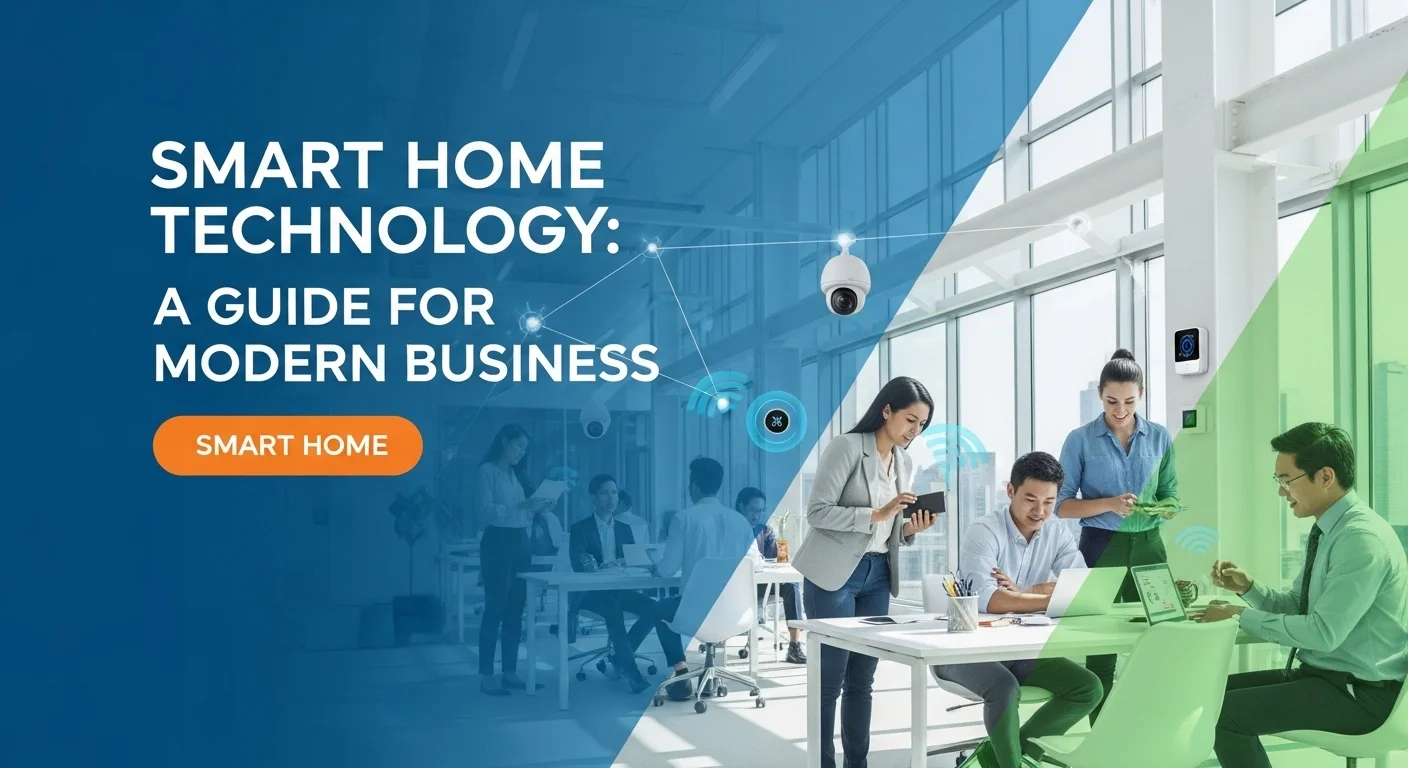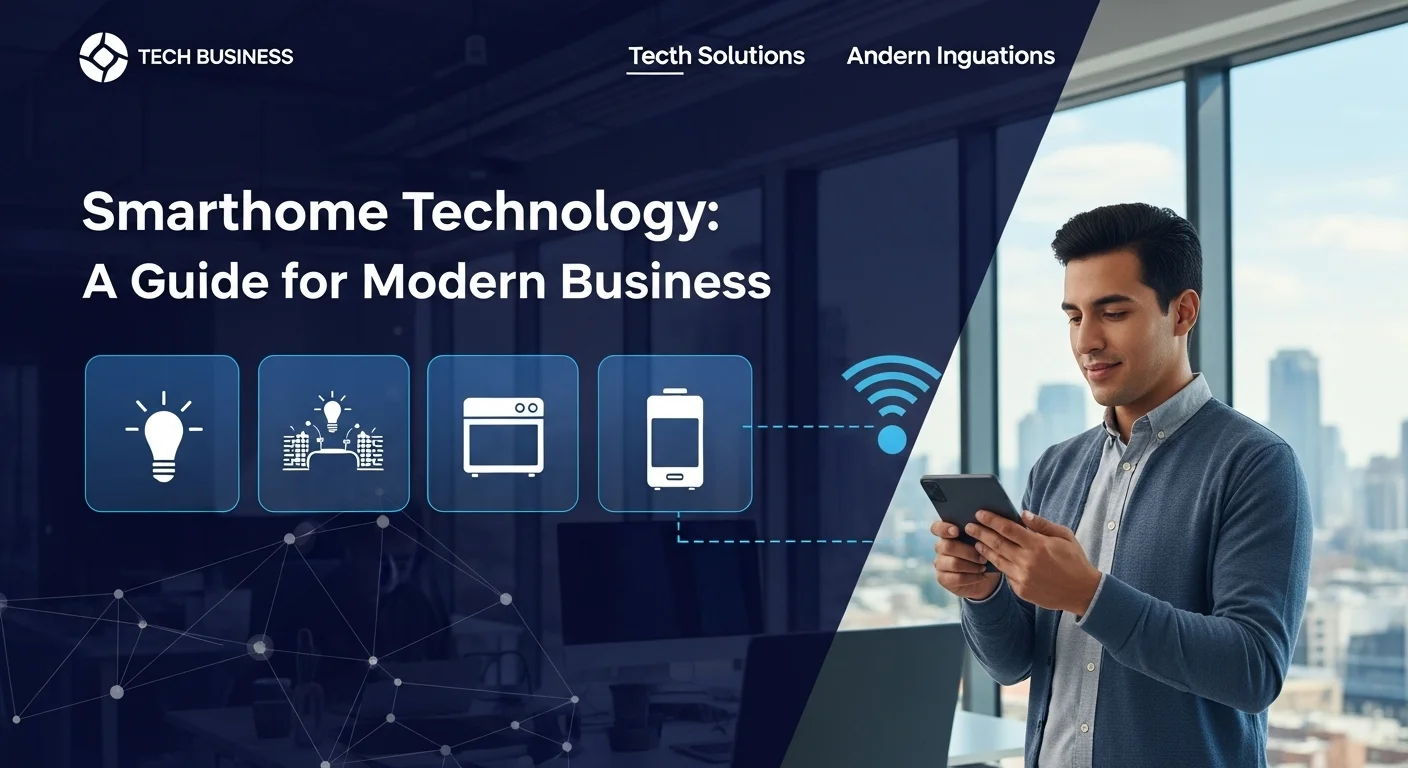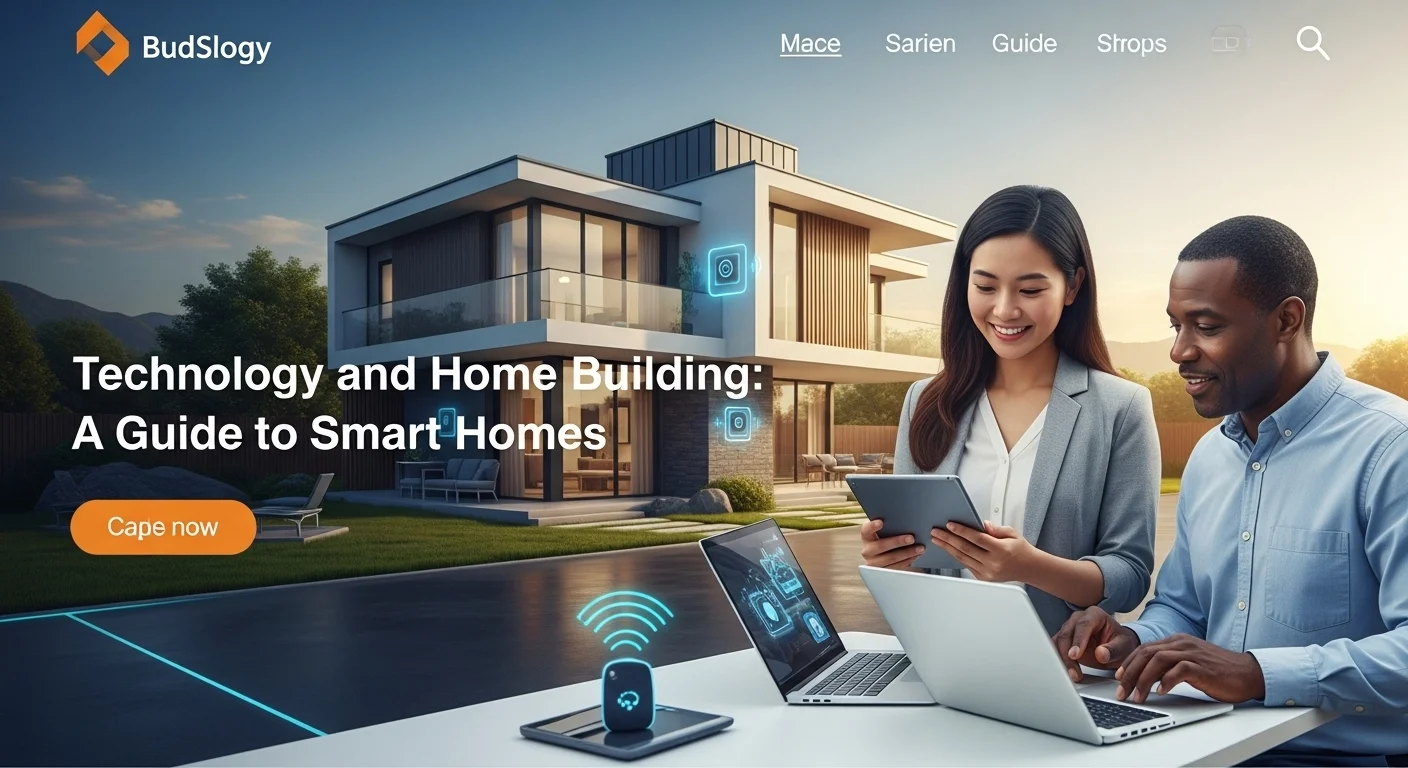The Ultimate Smarthome Guide: From Your First Smart Plug to Full Business Automation

Executive Summary
Ever wondered if a 'smart home' is more than just a cool gimmick? I've spent years wiring up everything from tiny apartments to full-scale businesses, and I can tell you: it's a game-changer when done right. This guide cuts through the technical noise. We'll explore the essential tech you need to know, from beginner-friendly ecosystems to powerful DIY platforms like Home Assistant. I'll walk you through how to build a smart, secure, and efficient space that genuinely makes life easier, whether it's for your family or your company.
Table of Contents
Table of Contents
- What is a Smart Home and Why Does It Matter?
- The Building Blocks: Hubs, Sensors, and Actuators
- The Unseen Network: How Devices Communicate
- A Complete Guide to Building Your Smart Home
- Choosing Your Ecosystem: The Brains of the Operation
- The Heart of the System: Finding the Right Hub
- Beyond Alarms: Integrated Smart Home Security
- Smart Technology in Business: Practical Applications
- Pro Tips for a Better, Safer Smart Home
- Best Practices for a Secure and Private Smart Home
- Creating Automations That Actually Help
- Future-Proofing Your Investment
What is a Smart Home and Why Does It Matter?
Let's be honest, the term 'smart home' gets thrown around a lot. At its heart, it's simple: a home where your lights, thermostat, locks, and other devices are connected to the internet, allowing you to control and automate them. I've seen it evolve from a niche hobby into a powerful application of the Internet of Things (IoT) that's reshaping how we live and work. This isn't just about the convenience of turning off a light from your couch. It's about creating spaces that are more efficient, accessible, and secure. For businesses, it's a frontier of innovation, opening up new ways to serve customers and streamline operations. The market is exploding for a reason—people are discovering the real-world value of intelligent automation.
The Building Blocks: Hubs, Sensors, and Actuators
To really get what makes a smart home tick, you need to know the three key players. First, you have the Sensors. These are the eyes and ears of your home. They detect things like motion, temperature, light, or whether a door is open. Think of a tiny sensor on your basement window that alerts you to a potential break-in. Next are the Actuators. These are the muscles—the devices that do the work. Your smart light bulb that dims, the smart lock that bolts, the thermostat that changes the temperature—those are all actuators. Finally, and most importantly, you have the Controller or Hub. This is the brain. It takes the information from a sensor (e.g., 'motion detected') and tells an actuator what to do ('turn on the light'). A good hub unifies all your different gadgets into one system. This is where you'll hear about products like the versatile homey hub smarthome controller, which can talk to a huge range of devices, or a system-specific hub like the smarthome insteon hub, built for rock-solid reliability within its ecosystem. For those of us who love to tinker, a platform like smarthome home assistant can turn a small computer into an incredibly powerful, private hub that you control completely.
The Unseen Network: How Devices Communicate
The magic of it all happens through invisible communication. Your devices are constantly chatting with each other using different wireless languages, or protocols. You already know Wi-Fi and Bluetooth—they're great but can be power hogs for small, battery-operated sensors. That's why dedicated smarthome protocols were born. For years, Zigbee and Z-Wave have been the main contenders. They are low-power 'mesh' networks, which is a fancy way of saying that each powered device helps pass the signal along, making the network stronger and more reliable. Then there's Insteon. The smarthome insteon protocol is unique because it uses a dual-mesh system, sending signals through both radio waves and your home's existing electrical wiring. I've used it in tricky installations where wireless signals struggled, and its reliability is impressive. Now, the industry is rallying behind a new standard called Matter, which promises to let devices from all the big brands finally play nice together. It's the universal translator we've all been waiting for.

A Complete Guide to Building Your Smart Home
Diving into the smart home world can feel like learning a new language, but it doesn't have to be complicated. Whether you're a business owner looking to innovate or just a tech lover wanting to build an amazing connected home, making the right choices upfront will save you a lot of headaches. Let's walk through it.
Choosing Your Ecosystem: The Brains of the Operation
Your first big decision is picking an ecosystem. This is the command center for your home, usually centered around a voice assistant. You have the big three: Amazon Alexa, Google Home, and Apple HomeKit. Alexa has the most device support, Google is brilliant at understanding natural conversation, and Apple is laser-focused on security and privacy. They are all great starting points. But, if you're like me and want total control, privacy, and customization, there's another path: smarthome home assistant. It's open-source software you run yourself. It has a learning curve, I won't lie, but it lets you connect almost anything to anything else without your data ever leaving your home. For any serious enthusiast or business, it's the gold standard for a reason.
The Heart of the System: Finding the Right Hub
Many of the best smart devices don't use Wi-Fi; they use Zigbee or Z-Wave to save battery and be more reliable. To talk to them, you need a hub. Think of the hub as the conductor of your smart home orchestra. A multi-talented conductor is the homey hub smarthome controller. A device like the Homey Pro is incredible because it has radios for just about every protocol out there—Zigbee, Z-Wave, and even the upcoming Matter standard. It's for the person who wants to mix and match the best devices without worrying about compatibility. On the other hand, you have hubs built for a specific purpose, like the smarthome insteon hub. It's the core of a smarthome insteon system, and its dual-mesh network provides a level of reliability that's hard to beat, especially in large homes or buildings with lots of concrete and steel. Your choice of hub really defines your system's philosophy: ultimate flexibility or specialized dependability.
Beyond Alarms: Integrated Smart Home Security
A truly smart home offers security that goes way beyond a traditional alarm. A modern smart home security system is one of the most powerful smarthome solutions you can implement. It starts with smart cameras and doorbells that let you see what's happening from anywhere. Smart locks and thermostats can let you give a temporary code to a dog walker or contractor. But the real magic is in the integration. I've set up systems where a smoke detector going off doesn't just make a noise—it also unlocks all the doors, turns every light in the house on to 100%, and shuts off the HVAC to stop smoke from spreading. That's a level of safety that separate, 'dumb' devices just can't provide. It’s about creating a home that actively looks out for you.
Smart Technology in Business: Practical Applications
These same ideas are transforming businesses. I once helped a small hotel chain implement smart rooms. Guests could control everything with their voice, which they loved. But the real win for the owner was behind the scenes: the system automatically set back thermostats and turned off lights in empty rooms, cutting their energy bills by nearly 20%. In real estate, smart features are a huge selling point. For property management, smart locks and thermostats are a godsend, allowing remote management and preventing energy waste. In assisted living, these technologies create a crucial safety net for residents. A robust platform like smarthome home assistant is perfect for these commercial setups because it's so customizable. Combined with versatile hardware like a homey hub smarthome controller or a hyper-reliable system built around a smarthome insteon hub, businesses can create powerful, efficient, and innovative experiences.

Pro Tips for a Better, Safer Smart Home
Building a smart home is a marathon, not a sprint. The tech is always evolving, so the best thing you can do is build on a solid foundation. I've learned a few things over the years, sometimes the hard way, that can help you create a system that's secure, genuinely useful, and ready for the future.
Best Practices for a Secure and Private Smart Home
Before you add another smart gadget, let's talk security. First, your Wi-Fi router is the front door to your digital life; lock it down. Change the default admin password and use a strong, unique password for your Wi-Fi. If you can, take this pro-tip: create a separate guest network just for your IoT devices. Think of it as a digital playroom that keeps your smart speakers and light bulbs away from your personal computers and sensitive files. It's one of the single best things you can do for security. Second, give every smart device and app its own strong, unique password. A password manager is your best friend here. And turn on two-factor authentication (2FA) everywhere. Finally, think about your data. This is why I'm such a big advocate for local-control platforms like smarthome home assistant. It keeps your data inside your own home, not on a company's server. No matter what system you use, from a homey hub smarthome controller to a smarthome insteon hub, always keep the firmware updated. Those updates often contain critical security patches.
Creating Automations That Actually Help
The whole point of this is automation, but bad automation is worse than no automation. The secret is to solve real, everyday problems. Start simple. Use your phone's location to create 'Home' and 'Away' scenes. When you leave, the lights turn off, the thermostat adjusts, and the doors lock automatically. It's a small thing that adds up. Then, start layering logic. My favorite automation is for nighttime. If motion is detected in the hall after 11 PM, the lights turn on to a dim 10%—just enough to see without blinding you. Platforms like smarthome home assistant or the 'Flows' in a homey hub smarthome controller are brilliant for this. Don't be afraid to experiment. Live with an automation for a few days. If it's annoying, tweak it or delete it. The goal is a home that anticipates your needs, not one that you have to fight with.
Future-Proofing Your Investment
The tech world moves fast. To avoid ending up with a drawer full of useless gadgets, you need to think ahead. Right now, the biggest name in future-proofing is Matter. When you buy new gear, look for the Matter logo. It's our best hope for getting devices to work together, no matter who makes them. Another smart move is investing in a powerful, multi-protocol hub like the homey hub smarthome controller. It's built to handle today's standards and tomorrow's, like Thread and Matter, ensuring it won't be obsolete next year. For the ultimate in future-proofing, my vote goes to smarthome home assistant. Its massive open-source community adapts to new tech faster than any single company can. It's also a great way to keep older, reliable systems like smarthome insteon relevant, acting as a bridge between your trusty smarthome insteon hub and the latest Matter devices. My final piece of advice: think in terms of solutions, not just gadgets. Instead of 'I need a smart plug,' think 'I want my coffee to be ready when I wake up.' This mindset will help you build a smarter home that lasts.
Expert Reviews & Testimonials
Sarah Johnson, Business Owner ⭐⭐⭐
The information about Smarthome is correct but I think they could add more practical examples for business owners like us.
Mike Chen, IT Consultant ⭐⭐⭐⭐
Useful article about Smarthome. It helped me better understand the topic, although some concepts could be explained more simply.
Emma Davis, Tech Expert ⭐⭐⭐⭐⭐
Excellent article! Very comprehensive on Smarthome. It helped me a lot for my specialization and I understood everything perfectly.



